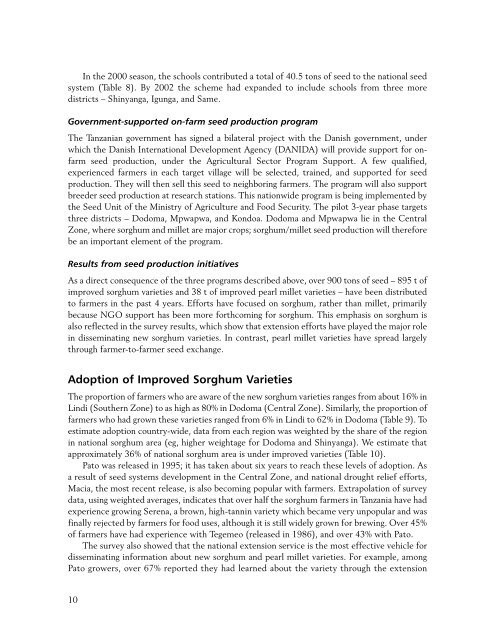Adoption of Improved Sorghum and Pearl Millet ... - Icrisat
Adoption of Improved Sorghum and Pearl Millet ... - Icrisat
Adoption of Improved Sorghum and Pearl Millet ... - Icrisat
Create successful ePaper yourself
Turn your PDF publications into a flip-book with our unique Google optimized e-Paper software.
In the 2000 season, the schools contributed a total <strong>of</strong> 40.5 tons <strong>of</strong> seed to the national seed<br />
system (Table 8). By 2002 the scheme had exp<strong>and</strong>ed to include schools from three more<br />
districts – Shinyanga, Igunga, <strong>and</strong> Same.<br />
Government-supported on-farm seed production program<br />
The Tanzanian government has signed a bilateral project with the Danish government, under<br />
which the Danish International Development Agency (DANIDA) will provide support for onfarm<br />
seed production, under the Agricultural Sector Program Support. A few qualified,<br />
experienced farmers in each target village will be selected, trained, <strong>and</strong> supported for seed<br />
production. They will then sell this seed to neighboring farmers. The program will also support<br />
breeder seed production at research stations. This nationwide program is being implemented by<br />
the Seed Unit <strong>of</strong> the Ministry <strong>of</strong> Agriculture <strong>and</strong> Food Security. The pilot 3-year phase targets<br />
three districts – Dodoma, Mpwapwa, <strong>and</strong> Kondoa. Dodoma <strong>and</strong> Mpwapwa lie in the Central<br />
Zone, where sorghum <strong>and</strong> millet are major crops; sorghum/millet seed production will therefore<br />
be an important element <strong>of</strong> the program.<br />
Results from seed production initiatives<br />
As a direct consequence <strong>of</strong> the three programs described above, over 900 tons <strong>of</strong> seed – 895 t <strong>of</strong><br />
improved sorghum varieties <strong>and</strong> 38 t <strong>of</strong> improved pearl millet varieties – have been distributed<br />
to farmers in the past 4 years. Efforts have focused on sorghum, rather than millet, primarily<br />
because NGO support has been more forthcoming for sorghum. This emphasis on sorghum is<br />
also reflected in the survey results, which show that extension efforts have played the major role<br />
in disseminating new sorghum varieties. In contrast, pearl millet varieties have spread largely<br />
through farmer-to-farmer seed exchange.<br />
<strong>Adoption</strong> <strong>of</strong> <strong>Improved</strong> <strong>Sorghum</strong> Varieties<br />
The proportion <strong>of</strong> farmers who are aware <strong>of</strong> the new sorghum varieties ranges from about 16% in<br />
Lindi (Southern Zone) to as high as 80% in Dodoma (Central Zone). Similarly, the proportion <strong>of</strong><br />
farmers who had grown these varieties ranged from 6% in Lindi to 62% in Dodoma (Table 9). To<br />
estimate adoption country-wide, data from each region was weighted by the share <strong>of</strong> the region<br />
in national sorghum area (eg, higher weightage for Dodoma <strong>and</strong> Shinyanga). We estimate that<br />
approximately 36% <strong>of</strong> national sorghum area is under improved varieties (Table 10).<br />
Pato was released in 1995; it has taken about six years to reach these levels <strong>of</strong> adoption. As<br />
a result <strong>of</strong> seed systems development in the Central Zone, <strong>and</strong> national drought relief efforts,<br />
Macia, the most recent release, is also becoming popular with farmers. Extrapolation <strong>of</strong> survey<br />
data, using weighted averages, indicates that over half the sorghum farmers in Tanzania have had<br />
experience growing Serena, a brown, high-tannin variety which became very unpopular <strong>and</strong> was<br />
finally rejected by farmers for food uses, although it is still widely grown for brewing. Over 45%<br />
<strong>of</strong> farmers have had experience with Tegemeo (released in 1986), <strong>and</strong> over 43% with Pato.<br />
The survey also showed that the national extension service is the most effective vehicle for<br />
disseminating information about new sorghum <strong>and</strong> pearl millet varieties. For example, among<br />
Pato growers, over 67% reported they had learned about the variety through the extension<br />
10

















